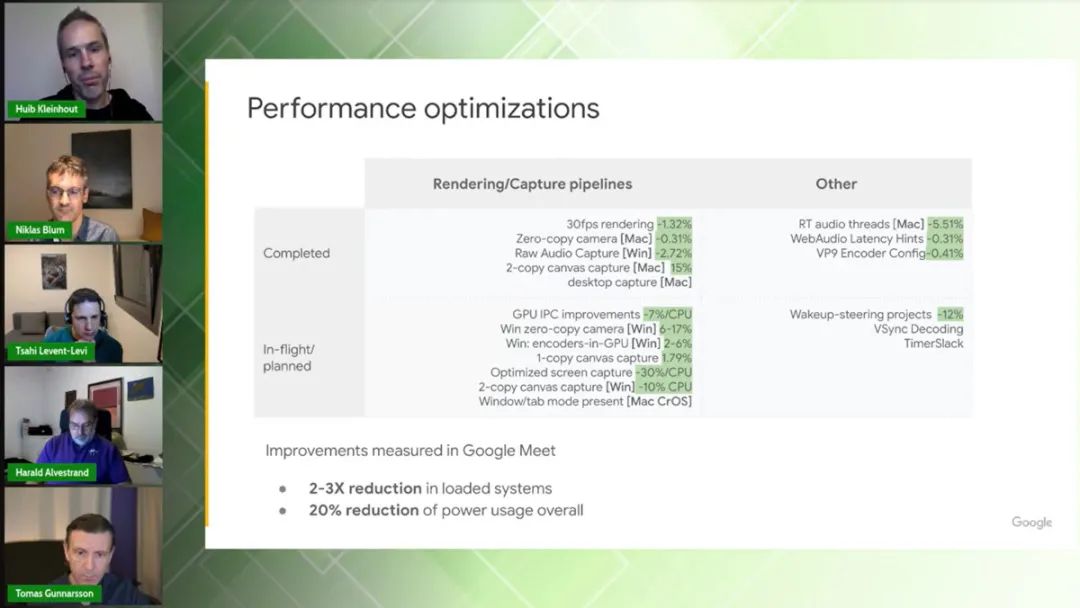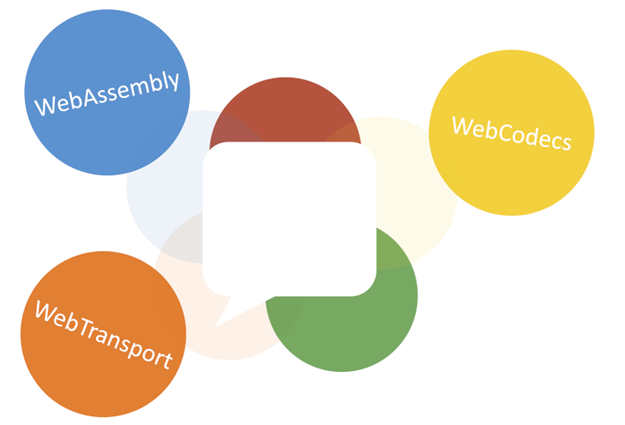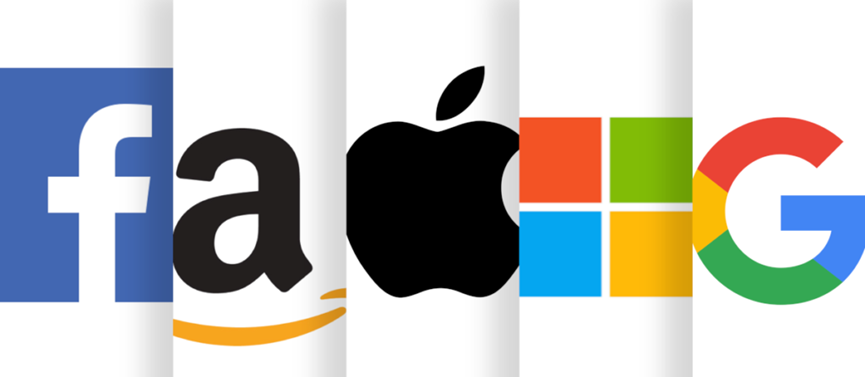
Click "LiveVideoStack" above to follow us
作者 | Tsahi Levent-Levi
Translation |
Technical review | Liu Lianxiang
WebRTC
Year-end inventory
#006#
This article is published on BlogGeek.me by Tsahi Levent-Levi, a WebRTC technical expert. We translated some of the content and published it on the official account of LiveVideoStack. Thanks to Tsahi for the authorization.
The five trends of WebRTC in 2022 are slightly different from what we have seen before: some focus on scale, some explore new requirements, and some focus on new markets.
scale and performance
There is a proverb in Hebrew: "Start fast, grow slowly". This proverb vividly describes where WebRTC is now.
This is clearly how WebRTC will evolve in 2021. Size is still very important, and in 2022 size will continue to be important.
At the Kranky Geek event in November 2021, Google engineers shared what they have done in the past year. Below is a slide that revolves around performance optimization. They can be seen working constantly and multitasking. Many of these tasks have already been accomplished, but there is still more work to be done.

These improvements are all aimed at providing better scalability to more participants joining a single conversation. The hardware codec bugs we've tracked in recent months will continue in 2022.
At the same time, we see many companies investing in infrastructure to expand their services.
2022 will continue 2021.
new technology
A host of new technologies are now starting to mature that will allow vendors to fully leverage the value of WebRTC. For example, at Kranky Geek, we spend a lot of time introducing these technologies and seeing the initial use of these technologies by various vendors.
WebAssembly

WebAssembly is quite possibly the best player among WebRTC technologies.
WebAssembly improves web code performance and enables cross-language compilation. For WebRTC, the main benefit is the use of WebAssembly for machine learning tasks of media manipulation. From noise suppression, to background replacement and video effects, to video lighting effects. These can all be achieved with WebAssembly.
I hope that more and more suppliers will use WebAssembly, and hope that WebAssembly can support more features.
WebTransport&WebCodecs

Not satisfied with WebRTC? There are also WebTransport and WebCodecs.
WebTransport and WebCodecs (together) can theoretically implement the encoding and decoding of media and sending or receiving media from the server.
The details make the difference, and while WebTransport and WebCodecs haven't reached the popularity to replace WebRTC, they are very promising.
It makes sense that we'll see more and more vendors experimenting with these technologies and using them with WebRTC. I made this point a year ago when Google was splitting parts of WebRTC.
Google itself is very enthusiastic about these new technologies, so there are also concerns about whether it will lose interest in WebRTC in a few years.
AV1
Then there are new codecs.
AV1 launched in 2018. Since 2018, there's apparently been a push for AV1 to be a WebRTC solution (not quite). In fact, at the end of 2021, AV1 still has not had a significant impact on WebRTC. Not because AV1 isn't good enough, but because it takes a long time to roll out new codecs, especially video codecs.
The wait is almost over, though. AV1 is coming to WebRTC, we will see its adoption in 2022, there are still limitations, but it will eventually become interesting and increase the relevance to WebRTC.
New machine learning-based audio codecs (think Lyra) are still a bit away. There is currently no consensus on which audio codec it should be. AV1 doesn't have this problem - we already know it will be the next codec under Unified Consensus.
WebRTC infrastructure, hyperscaling and SD-WAN

The way WebRTC is designed and deployed is changing. The usual mesh/mix/route solutions still exist. Many people also choose a hybrid approach. Much of the recent discussion and attention revolves around hardware, hardware deployment, and how to accurately forward packets. AcousticWeb was perhaps the first company to publicly use this technology at scale, and tout it as a better solution. In 2021, we see Subspace and Cloudflare announce the deployment of more than 100 regional data centers for hosting TURN services.
I have listed infrastructure as one of the challenges facing WebRTC in the 2021 Workshop. In 2022, this topic will become even more interesting. Anycast will enter the fray as a vendor technology.
We can't yet tell which technologies will be favored in 2022. Will these technologies lead to a real difference in value and a measurable increase in quality when used in a dozen regions around the world? Is it worth it? Especially with the big cloud players rolling out new data centers every other month.
live streaming

From features and technologies to use cases.
Live streaming via WebRTC.
Other technologies can also achieve live broadcast, but they are not as efficient as WebRTC, and can run in the browser.
People are becoming more and more accustomed to using video communication. COVID-19 has spawned many new ways to communicate remotely. People are eager to interact in a live, real-time manner. A 2-second delay might be okay, but a sub-second delay would be even better! We will see more and more providers achieve sub-second latencies using WebRTC. For many use cases, low latency has more room to grow. But to achieve instantaneous latency, it requires more usage of WebRTC. At least until the WebTransport and WebCodecs technologies mature.
From 2D to the Metaverse
Everyone is rethinking the future of communication in ways other than talking to a camera that we've relied on for the past 20+ years.
The two ultimate directions I see:
Place video sessions in a composite environment of 2D and 3D where the user's Avatar can come and go freely.
A Metaverse led by Facebook and Microsoft (at least for now).
In 2022, we will also see more discussions about the Metaverse. Now, with so many different metaverse experiences launched, which ones are short-lived and which ones will stay will be the most interesting thing to watch in 2022.
WebRTC market power

As we move into 2022, it is important to know which companies are the major players and major market forces in WebRTC.
Big Tech: FAAMG and WebRTC

These largest tech companies lead the development and make decisions about WebRTC, each with their own motivations:
Google: Google is the largest user of WebRTC in the browser, with tools like libwebrtc, Chrome, Google Meet, and Stadia that use WebRTC. In most cases, Google's requirements will directly affect WebRTC.
Microsoft: Microsoft owns Skype, Azure Communication Services and Teams. They all use WebRTC (at least in web browsers). Microsoft is also pushing its own solution around WebRTC (although most of them currently only optimize certain areas for the Windows operating system and Office products).
Apple: Apple seems to be slow to respond to WebRTC, it looks like it was forced to get involved rather than actively joining WebRTC. The FaceTime web version should be Apple's most public support for WebRTC so far. Apple uses libwebrtc without contributing to it. Even if everyone is "hijacked" by Safari's poor WebRTC implementation, only Apple can improve this.
Amazon: Amazon is quietly adding services and products that use WebRTC. These services and products include Kinesis, Chime SDK, Amazon Connect and Alexa, etc. Amazon seems to be content for the moment and doesn't care too much about the WebRTC standard and its implementation in specific browsers.
Facebook: Facebook owns Messenger, Instagram, and Whatsapp, and it probably has the most WebRTC traffic.
Also included on the above list is Intel, which is pushing for hardware encoding of WebRTC (a thing that is often overlooked by hardware vendors).
In 2022, these companies will all be the shapers of WebRTC. They will decide whether to listen to external feedback and incorporate this feedback into their own product roadmap - which will affect everyone in the WebRTC ecosystem.
Twilio not interested in WebRTC

As I stated in " Concerns and Thoughts on WebRTC Development ", Twilio really doesn't take WebRTC that seriously. Twilio couldn't gain much with WebRTC, so turned its focus elsewhere. However Twilio's video-js repo is a really good source of bug reports (Twilio and Vonage are way ahead of most companies in this regard).
In the face of leading CPaaS providers (such as Twilio), the options for other providers include:
Can work hard to develop the market in the field of WebRTC and video.
Or try to compete with Twilio in areas other than WebRTC.
But it's not the best environment for companies looking to use CPaaS. To some extent, the above options are also not efficient for companies that want to have CPaaS.
It also reduces the leverage that CPaaS providers have (or want to have?) over the direction of WebRTC. There are tens of thousands of companies, use cases, and requirements behind these vendors, and it would be great if their voices were heard more and more. This is part of the reason I think UCaaS will surpass CPaaS in terms of innovation.
Problems facing Zoom
Will Zoom be an exception?
Zoom doesn't really use WebRTC, but it affects everything around WebRTC.
1. Vendors using WebRTC often end up competing with Zoom in the marketplace:
Compete in many verticals and market segments.
As a typical representative of remote interaction in the new crown epidemic, the advantage of Zoom is that it is widely known and has been used by many companies.
2. Performance comparison between WebRTC and Zoom:
Gallery View from Zoom can display up to 49 participants.
WebRTC introduces REDundancy in Opus coding.
The CPU usage of the two, etc.
3. Zoom believes that WebCodecs+WebTransport+WebAssembly will become a substitute for WebRTC, and is seeking differentiation from other companies:
Will anyone else go down this road?
Will Google also accept this replacement at some point and lose interest in WebRTC?
Time will prove everything.
Although Zoom is not a member of the WebRTC ecosystem, it will affect the WebRTC market to a large extent.
Cooperative Competition in WebRTC

Cooperative competition is everywhere. We see a lot of competitors coming together and collaborating, especially in standards organizations, where vendors are trying to create an environment where everyone is happy. The decision to enforce the implementation of video codecs in WebRTC is a good example.
Today, more and more companies are collaborating directly with each other—competing with each other on the one hand, and collaborating with each other on the other. Microsoft improved screen sharing in Google's libwebrtc (after deciding on Chromium for Edge), Intel helped with AV1 hardware encoding, RingCentral and 8x8 pushed to add RED to Opus in WebRTC, and more.
As we all know, we cannot stand by and watch the implementation of WebRTC, and we should initiate more active cooperation. Vendors should openly invest in more open source implementations rather than just developing their own proprietary code.
This is just my wishful thinking, but WebRTC has reached a turning point, and the entire community and ecology need to work together to achieve the next step in the development of WebRTC.
More expansion content:
https://bloggeek.me/webrtc-insights/
https://webrtchacks.com/red-improving-audio-quality-with-redundancy/
https://bloggeek.me/a-blueprint-to-improving-webrtc-media-quality-using-ai/
https://bloggeek.me/why-cpaas-is-losing-the-innovation-lead-to-ucaas/
https://bloggeek.me/managed-webrtc-turn-speed/
https://bloggeek.me/webrtc-unbundling/
thank you
This article has been authorized to be translated and published by the author Tsahi Levent-Levi, thank you very much.
Original link: https://bloggeek.me/webrtc-trends-for-2022/
More year-end technical inventory:
Talk about the development of the QUIC protocol
Audio and video go to sea, how to ride the wind and waves?
The Technical Basis and Development of Interactive Whiteboard
Scan the QR code in the picture or click to read the original text
Learn more about the conference

Click " Looking " if you like our content!
